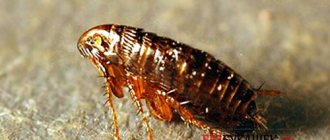How domestic cats get fleas
The first fact is that a flea can jump 100 times its body length. Add to this a small amount of cunning and you get an insect that can penetrate anywhere on the planet.
In short, anything or anyone can unknowingly bring an insect into the house. It's quite easy for them to jump on your clothes as you roam the streets. She doesn't think about riding on her pants, socks or shoes.
Or maybe your dog goes outside to play for a bit, picking up a flea before returning. They are so tiny that they can even enter your home on their own, jumping through ventilation or entering through the smallest cracks in a door or window.
Once inside, the baby falls on your cat.
How to rid your pet of fleas
For most dog owners, the most difficult thing is not how to deal with these blood-sucking insects, but how to choose the right product to combat them so as not to harm the health of your pet. There are a lot of antiparasitic agents on the market today, and most of them are quite effective in combating harmful insects. But still, a specific drug is best suited for each animal.
What antiparasitic drugs are offered by modern manufacturers, all the pros and cons of this or that product, read the article: Modern flea and tick remedies for dogs.
From one flea to hundreds
- After a small feast on the poor house cat, the flea jumps off to lay hundreds of eggs, which quickly hatch into hungry larvae.
- After some time, these larvae turn into adults, ready to quench their thirst for blood. Thus begins another cycle.
- The worst thing about this situation is that your cat cannot escape from the bloodthirsty creatures. No matter how many cats you have, fleas simply refuse to go away. Anyone who has dealt with an infestation knows how quickly the problem can spread to other pets in your home.
- Fleas can disrupt an animal's happy-go-lucky lifestyle, and can possibly cause anemia and tapeworm infestation. If your cat is constantly scratching or has any skin problems, fleas may be partly to blame.
Where do fleas come from?
In domestic cats, fleas or parasitic insects always appear unexpectedly. It does not matter whether the cat walks in the yard or does not leave the premises. Fleas can jump into an apartment from a person’s outer clothing or shoes. Sometimes they enter from neighboring rooms through cracks in the floors or thresholds.
The main ways in which fleas can appear on animals are:
- from another infected animal;
- through household items on which there were parasite eggs;
- through the clothes or shoes of the cat's owner;
- from neighbors who have an infected animal.
Something else interesting: Cat fever - what to do, how to treat?
A person cannot become infected with fleas from an animal, since they prefer to hide in the fur and feed on cat blood. But humans can act as a carrier of parasites. Fleas jump onto people's clothes and move to another habitat. In close contact with a sick animal, parasites can get into the folds of clothing.
There are cases of human beings bitten by cat fleas. If insects jump on the carpet, they may well leave a mark on the bare legs of the apartment owner. To avoid this situation, it is necessary to urgently remove fleas from your cat as soon as you notice the first symptoms of infection.
Important! To prevent infection by parasites, you need to wet clean the room once a week, thoroughly vacuum and wipe off the dust. It is in particles of dust and dirt that insects can hide.
How to tell if your pet has fleas
Before you start fighting fleas on cats, you should definitely make sure that they are the ones that are tormenting your animal.
It is not difficult to identify insects on an animal’s body; just watch the cat for a few minutes. Your cat has fleas if:
- she constantly itches in different places, changing her position. She bites into the skin and clicks her teeth;
- stops sleeping normally, gets nervous and moves from place to place;
- she constantly meows, trying to attract your attention;
- there are brown clots on the skin (insect feces);
- when combing, parasites jump out of the fur.
It should be noted that at the first stage of infection, it is difficult to understand that you need to remove fleas from a cat. The only symptom will be minor scratching. But as insects multiply, your animal can change a lot. Constant itching and bites will make your pet nervous, thin and gloomy.
In order to start fighting fleas in cats in a timely manner, you need to constantly monitor the animal, noting all the changes that occur. Treating your pet at an early stage will save him from excruciating suffering.
Treatment
Because they reproduce so quickly (the eggs hatch in 3–10 days), they are difficult to treat.
But instead of running out and buying the first flea shampoo you see on the shelf, you should talk to your veterinarian, who can recommend treatment. Worried about toxins in medications?
Believe it or not, good old soap and water will help kill fleas on your cat. An even better non-toxic solution is a flea comb—with very fine teeth—combined with the aforementioned soap and water.
Where do fleas come from in a domestic cat and cat if he does not go outside?
A domestic cat becomes infected with small bloodsuckers when:
- Invasion of a flea family on a person. It's easy to find out. Adults and eggs are easily carried on outdoor shoes and outerwear.
- Exit to the landing. There are no fewer fleas living in a doorway than on the street. The danger increases for residents of apartments located on the ground floor. They may appear in the apartment. The proximity of the basement causes a concentration of infected stray animals.
- Direct interaction with an infected person. Parasites can also appear from rats that have entered the house. A cat can also become infected from a foster cat. It is easy to determine if there are parasites on the fur.
Dangerous ectoparasites cause discomfort to animals
Where do fleas come from?
Many people believe that fleas in the house are associated with pets. This is only partly true. Fleas can migrate from the street, from the landing, from neighbors. They can be brought from the street on your feet or shoes. The diet of these insects includes animal and human blood. A person will be able to guess that fleas have appeared in his home after he notices small bites on his body.
Where do fleas come from and what do they look like? These parasites can be up to 5 millimeters in size. Their body is flattened on the sides and has bristles. Thanks to such features, insects can easily, on the one hand, cling to animal fur, and on the other hand, move between the hairs. In birds, fleas can hide between feathers and in nests. Fleas have three pairs of legs and can jump distances that are many times their own size.
Flea bites are unpleasant because... cause severe itching, and in some - allergic reactions. In addition, fleas can carry diseases such as plague, hepatitis and others. Therefore, you need to get rid of them quickly.
Types of fleas
Insects are classified according to:
To preferred owner
Depending on their food source, parasites are divided into:
- felines;
- canine;
- rats;
- human.
cat flea
Habitat
Based on where they are concentrated, insects are divided into:
- linen, preferring upholstered furniture and bed linen;
- earthen ones, living in the upper soil layer;
- sandy, found in coniferous forests.
What do cat fleas look like?
Cat fleas, called "ctenocephalides felis", are distinguished by:
- small (no more than 0.5 cm) body, flattened on the sides;
- the ability to change size after consuming blood;
- three pairs of powerful limbs, allowing you to jump 19cm high and 30cm long;
- chitinous body providing protection from mechanical influences;
- dark shade of brown with shine;
- a clear difference in size between males and females;
- an impressive number of spines and bristles that prevent them from falling off the owner;
- mouthparts adapted to pierce the skin and subsequently suck out blood.
If other insects are disdainful of other types of blood, then the cat flea is not at all averse to snacking on the blood of a person or dog.
Life cycle of a flea
The life cycle, lasting 2 years, sequentially goes through the following stages of rebirth:
- Egg. During her life, the female is capable of laying almost 1000 eggs.
- Larva. Hatching occurs after 2 weeks. The larvae live adjacent to garbage, preferring to feed on organic matter and excrement.
- Doll. During pupation, the larva becomes resistant to any influences and easily survives frosty winters or drought.
- Adult. At this stage, the insect finds a host and leads a parasitic existence.
That is why this type of flea family is more widespread.
Common flea
Fleas are wingless blood-sucking insects that parasitize on the surface of a living organism and feed on the blood of their “host”. The flea's mouthparts are designed in such a way that the insect easily pierces the skin and sucks out blood, leaving wounds on the body that cause itching, pain and inflammation. Tenacious fleecy legs and a flat body easily allow the flea to move between the hairs of the animal, in the folds of clothing and stay on any surface at any angle.
Often, when seeing insects on an animal’s body, many owners think that these are 100% fleas, but they may confuse them with lice or lice.
The flea body size varies from 1 to 5 mm. The color ranges from reddish to almost black, while in lice eaters it is translucent gray or almost white. The body of a flea is flattened laterally (vertically), whereas in lice eaters it is flat horizontally. The hind limbs of fleas are very well developed, thanks to which the insect can cover vast distances in one jump.
Fleas do not look for special places to lay eggs. For more successful distribution, females release eggs in small portions in different directions. The eggs get into the animal's fur, carpets, furniture, and plants. Most of these larvae will certainly survive and return to their “host”. Therefore, when you find fleas on your pet’s body, it is important not only to treat it, but also to disinfect the entire room where the infected animal lives.
And this is what these “aliens” look like under a microscope. Isn’t it true, you wouldn’t really want these “aliens” to live on your furry pet.
Ways to combat parasites
To combat fleas use:
- Shampoos (leopard, insectin, phytoelite). Suitable for wool of any length and does not cause allergic reactions. They help remove the first symptoms and signs of fleas. In addition to removing parasites, it helps improve the appearance of the coat and the condition of the skin. Safe for small kittens, pregnant and lactating cats.
- Tablets (comfortis, sentinel flavor tabs, bravecto). They give good results for a long time. One of the disadvantages is the difficulty of feeding. However, the problem can be solved with the help of an introducer.
- Drops on the withers (fipronil, ivermectin, permethrin). They help quickly get rid of insects, but are not suitable for all cats due to possible intolerance to the incoming components.
- Sprays (hartz, frontline). Easy to use and suitable not only for the pet, but also for treating the room.
- Anti-flea collars (bolfo, hartz). May cause hair loss. Used as an additional or preventive measure.
Find a hard surface and use your fingernail to halve the parasite.
Drops on the withers from parasites
Are parasites really that dangerous?
Unfortunately, not all owners of pet cats understand the danger that cat fleas in their pets pose to themselves and to humans.
Danger to animals
Unpleasant facts about why fleas are dangerous for cats:
- violation of the integrity of the skin due to parasite bites leads to the development of flea dermatitis and allergic reactions;
Allergic dermatitis in cats due to flea saliva
- fleas are carriers of helminth eggs, infecting domestic animals with worms;
- when infested by fleas, the risk of developing mycoplasmosis and rickettsiosis increases, since parasitic insects can carry dangerous fungal and viral infections;
- blood-sucking insects are carriers of hemobartonellosis (infectious anemia);
- insect bites lead to a deterioration in the physical and mental condition of the animal, the cat becomes nervous and hysterical;
- areas of baldness occur and appearance deteriorates;
- appetite decreases, weight decreases;
- Blood-sucking insects pose a great danger to small kittens, causing them anemia and exhaustion.
We recommend reading an article about how lichen is transmitted from a cat to a person. From it you will learn about the ways in which a cat can become infected with lichen, the symptoms of the disease in a pet, what to do to prevent the owners from becoming infected, and what to do if an infection has already occurred.
Danger to humans
As a rule, cat fleas live on their immediate owners - cats. But they can also cause trouble for household members, periodically attacking them. The danger of external parasites to humans is as follows:
- insect bites cause an allergic reaction, swelling, itching (this is due to the fact that when bitten, the parasite injects an anesthetic substance, which is a strong allergen for humans);
- fleas are potential carriers of diseases dangerous to humans such as typhoid fever, hepatitis, plague and even anthrax;
- In addition to infectious diseases, bloodsuckers can infect humans with eggs of roundworms, flukes and other helminths.
Thus, the danger of cat fleas for both pets and humans is obvious. Therefore, the owner of a domestic cat should know how to determine that a cat has fleas, and not hesitate to treat the animal for blood-sucking insects.
Similar articles
- Flea and tick drops for cats: where to drop, how often...
Dangerous bronchitis in cats: signs of presence, treatment and prevention. ... The main principle of how flea drops work for cats is ... You should also limit contact with the treated pet of children, sick and elderly people. Read more - How to rid a cat of fleas using folk remedies, than...
How dangerous is hypertrophic cardiomyopathy in cats and how is it treated? Types of cysts in cats, methods of diagnosis and treatment. ... Effective and inexpensive methods to combat parasites or how to rid a cat of fleas using folk remedies. Read more
- How does a flea collar for cats work and is it real...
Universal collars repel not only cat fleas, but also more dangerous parasites - ticks. ... Effective protection for a long time. How long to wear a flea collar for cats depends on the type of impregnation. Read more
- Why does my cat's hair fall out and come out in clumps...
We recommend reading about how fleas reproduce in cats. You will learn about the stages of development of the parasite, their life expectancy, and what danger fleas pose to cats and humans. Read more
- How is lichen transmitted from a cat to a person, to a cat, how...
Therefore, every animal lover should know why lichen in cats is dangerous for humans. ... How fleas reproduce in cats: how many of them live on... Marina (content manager). Read more
Where does a domestic cat get fleas?
Almost every cat owner is familiar with the situation when a pet has fleas (at the same time, the four-legged pet has never left the room in which it lives and has not communicated with its own kind). Read on to find out what these parasites are, where they come from, why they are unpleasant and how to get rid of fleas on a cat.
A flea is a very small insect without wings. It is distinguished by its special jumping ability and mobility. Thanks to their flat body, as if compressed by something, fleas easily avoid external damage - they can almost never be destroyed with your fingers (only if you firmly squeeze them between your nails and crush them). Naturally sharp jaws that dig into the skin of the poor victim are needed to drink blood. Their bites are indeed quite painful.
If the cat is pregnant
How to get rid of fleas from a cat that is about to lamb? The main rule when processing: the drug should not enter the animal’s body. It can affect the course of pregnancy, the birth of unhealthy offspring, and miscarriages.
The fight against fleas in cats expecting offspring comes down to the use of collars, shampoos or drops. The safest thing is a collar. Droplets through the skin can enter the cat's blood and milk. Therefore, cats should not be used as experimental animals. The use of shampoos is possible if your pet loves to bathe, otherwise she will be stressed.
It is important to know: We must get rid of fleas from a pregnant cat, otherwise the kittens will become infected later. For them, the bites will be painful, they can cause itching and infect small pets with worms. Therefore, the cat must initially be healthy and have clean, parasite-free fur.
A nursing cat requires a special approach. Even collars are dangerous because kittens can bite or lick them. What to do in this case? It is advisable to use drops that do not penetrate the blood. But it is better to consult a veterinarian.
The way to remove fleas from a cat that is nursing is as follows: wait until the kittens are 3-4 weeks old, when the cat can leave them for a short time and wash it with shampoo, rinse thoroughly, and dry the cat. After all, if a cat has fleas, then kittens will also have them, so small pets will also have to get rid of them, and they will also have to be bathed.
Causes of fleas
Veterinarians unanimously declare: yes, fleas can appear even in those well-groomed animals that never, under any circumstances, go outside. The owners or their guests can bring them to the house or apartment personally. On clothes and shoes, with the hair of other animals, on children's transport. It only takes one such blood-sucking parasite to get inside the room, and your cat will immediately be attacked.
And although isolation and refusal to walk outside the home does not protect against parasites 100%, they significantly reduce the risk of becoming infected. So, there is an effect from such a precaution. Of course, when an animal is allowed to leave the house, it inevitably interacts with other four-legged animals (house and farm animals), and this risk becomes much higher. Furry participants in exhibitions and “cat” competitions can also pick up the cause of itching in the areas where the events are held.
You should not hope that there will be fewer fleas in winter. Yes, parasites love warm weather, but they also tolerate cold well. Therefore, you can “bring” them in throughout the year. Moreover, the colder it is, the more they strive to get into a person’s home - into the most comfortable living conditions for them. If severe frost kills them, then in the warmth of the house they feel like in paradise.
So the question of fleas in cats is out of season. They are not easy to eliminate, and they pose a threat even to stay-at-home pets.
Routes of infection
Fleas that parasitize cats are the most common blood-sucking insects in the world. This is due to the fact that they multiply very quickly and adapt to all environmental conditions. But the question arises, where do they come from in a house that is constantly being cleaned? And how does an animal that does not go outside become infected with these parasites?
© shutterstock
There are many ways of infection.
Most often, fleas appear on a domestic cat when:
- parasites entering the house through the shoes and clothes of family members;
- young kittens take over fleas from their mother cat;
- a domestic cat can become infected with fleas if it hunts rodents that are infected;
- it is possible to become infected after visiting a veterinary clinic. Homeless, homeless, stray animals are often brought to such places, which are sources of parasites;
- visiting exhibitions, competitions and various competitions significantly increases the risk of infection. Some owners may not provide proper attention to their pets, or may not yet be aware that the cat is infected;
- when traveling on public transport;
- fleas can get into the house through a guest who has an infested pet.
Parasite eggs remain on carpets, furniture and other items in the house. Here they ripen, but already mature individuals look for a host. Therefore, the animal can easily become infected with insects. Even a cat that has no contact with its other relatives, and does not go outside or go for walks, has a fairly high chance of becoming infected.
© shutterstock
When parasites are discovered in their pet, the owner thinks what to do with them and how to fight them? We need to take action to destroy them immediately. The first thing you need to do is buy a special product that can remove these parasites.
It is worth paying attention when choosing a product. The first thing you need to pay attention to is the release form. There are quite a lot of them, they are presented in the form of: shampoos, lotions, drops, powders, sprays and so on.
How can you tell if a cat has fleas?
You can quickly detect parasites if:
- observe the animal (restless behavior, sharp and frequent reactions to itching, even wounds due to biting into the skin);
- look for traces of the presence of insects (examine the surface of the skin for adults; lower the cat onto a white sheet of paper and comb out the fur or wipe the pet with a white paper towel; if you see black and brown dots, these are traces of flea feces, which turn brown under the influence of a drop of water shade);
- visit a veterinarian (he will accurately determine the presence or absence of fleas).
The likelihood of fleas in four-legged felines increases with dermatitis, hot or pulsating areas on the pet's skin, hair loss or bald patches.
How to tell if your pet has fleas
It is important to understand what fleas look like on cats in order to distinguish them from other parasites. The cat flea - Ctenocephalides felis, is a small, 2 - 3 mm in size, blood-sucking insect with an elongated body, usually dark brown or black in color. Fleas do not have wings. Their distinctive feature is long jumps due to their highly developed hind limbs.
Flea development cycle
Insects feed on the blood of their host, and most often they adhere to species specialization, i.e. parasitize on their own species (cat fleas on cats, canine fleas on dogs, etc.). However, the same cat fleas often bite humans, but quickly leave his body in search of their specific host.
The development cycle of an insect from egg to adult is about 2 weeks. In this case, eggs and larvae can survive for a long time in the external environment. Most often they accumulate in animal bedding, on carpets, in clothes, in cracks between furniture, under baseboards.
How can you tell if a cat has fleas? It’s not difficult to identify this if you take a close look at your pet’s behavior:
- the domestic cat itches intensely;
- the animal often gnaws its skin with its teeth, trying to bite someone;
- the pet becomes nervous, sometimes runs around the apartment, meows.
This behavior of the cat should prompt the owner to conduct a thorough inspection of the fluffy coat. To do this, you should arm yourself with a rare comb (comb). Using a comb to part the fur and blowing through the hairs, you should carefully inspect the skin. Fleas will be visible not on the pet’s fur, but on the skin. In addition to detecting sexually mature individuals, their excrement in the form of black dots or coarse black dust is also found on the skin of the animal.
If there are still a few individuals living on the cat, they may not be detected immediately. The skin on the neck, back and abdomen should be carefully examined. If an animal is massively infested with blood-sucking insects, they can be seen almost immediately after the fur is pulled apart.
To find out that a cat has fleas, you can use the following effective method. To do this, the animal must be thoroughly combed with a fine-toothed comb (slicker brush) and the contents shaken onto a white sheet of paper. Insect excrement will be clearly visible on a white background.
It is very difficult to catch a blood-sucking parasite. The insect is small in size and jumping. The hard chitinous cover and the laterally flattened body make it difficult to destroy the caught specimen. An accidentally caught adult can only be crushed on a hard surface by pressing down with a fingernail.
How to remove fleas from cats?
It is a mistake to think that regular cleaning of the rooms and thorough bathing of the animal is enough to prevent parasites. Cleanliness is great, but even it does not provide a 100% guarantee that a domestic cat will not have fleas.
All it takes is one single parasite jumping over the threshold for peace and comfort to end. And here's the thing. Fleas reproduce incredibly quickly. Only the first of them leaves behind about fifty eggs a day. And further in a circle. Only two months will pass and one unit of the parasite will turn into a horde of fleas, numbering hundreds or more eggs. This is so terrible that it will no longer be possible to ignore the disaster. And if for some reason you have not poisoned parasites before, then you will have to use all the recommended flea remedies.
According to statistics, adult parasites are only one twentieth of the entire flea population in your home. You simply don’t know about the existence of the remaining 95%, but they are about to turn into an army of pests. And if you don’t destroy them, the problem will soon return in an intensified manner. It is necessary to fight both living parasites and what they lay - eggs, larvae, pupae. And for this it is better to consult a veterinarian or even an exterminator.
Often, in order to remove fleas from a cat at home, it is necessary to carry out cleaning in several approaches. Only then will the animal forget about insects and the living space will become the same. And, of course, remember: the best way to kill fleas is their timely prevention. Treat your four-legged friend with anti-flea products and put a special collar on him.
How to recognize a flea
The cat flea is one of the smallest parasites from the flea order. The flea has a flattened body, a small head and a large belly. The size of an adult does not exceed 3 mm (for comparison, moose fleas can reach 12 mm). The parasite's body is covered with a large number of bristles, which allow the insect to stay on the cat's body. Fleas do not have wings, but their hind legs are adapted for jumping. An adult flea is capable of jumping up to 50 cm in length, so flea removal from domestic cats is carried out repeatedly. Fleas return to their homes some time after treating the animal's fur.
No scratching - no fleas?
Most owners of pets think that if their pet is not bothered by itching, then there are no insects. But the animal may begin to itch only when the parasites are gnawing on it. And while only a few individuals are running on the surface of its skin (which does not last long), it may not show external disturbance. Therefore, you should periodically examine your pet’s fur in order to detect your pet’s enemy at the initial stage of infection. It also happens the other way around, when the cat itches but there are no fleas. A veterinarian will help you find the cause of the itching (allergies, stress or other diseases cannot be ruled out).
So, we found out that the problem of parasites is relevant for all pets at any time of the year. The main thing is to know how to remove fleas from a cat and disinfest the entire living space.
Sources:
https://petszona.ru/otkuda-blohi-u-domashnej-koshki/ https://kotsobaka.com/koshki/bolezni-i-lechenie-k/otkuda-blohi.html https://vkpitomets.ru/sovety /koshki/otkuda-u-domashnej-koshki-bloxi.html
Why are cat fleas dangerous?
An infected cat's character changes, it becomes irritable and nervous. But the danger of parasites lies not only in changing the pet’s behavior. Fleas are dangerous insects; they are carriers of dangerous diseases. When fleas appear, a cat may develop:
- anemia. Constant bites lead to blood loss;
- allergy;
- dermatitis;
- psoriasis;
- helminthiasis (fleas carry helminth eggs);
- reckitsiosis;
- and other dangerous diseases.
Fleas can cause your pet to completely lose their fur and even cause plague. Therefore, as soon as you notice a black jumping dot on your pet, start taking measures to remove fleas from your cat.
The danger of infection in kittens
Since the kitten’s body is not yet strong, any illness can end in disaster for it. Flea infestation is no exception. When the “bloodsuckers” appear, the kitten begins to lose weight sharply. Blood loss leads to anemia. If there are a lot of parasites, the infection can end sadly for the furry baby. If you don’t think about how to cure a kitten in time, it may die.











